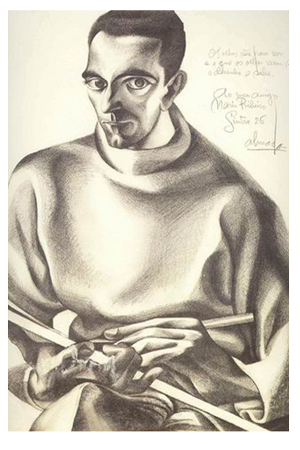|
ALMADA NEGREIROS 1893-1970 |
Auto-retrato, grafite sobre papel, 1926 (pormenor) |
|
1893 |
José Sobral de Almada Negreiros is born in S. Tomé on the 7th of April. |
|
1896 |
His mother dies. |
|
1900 |
Sent to a Jessuit boarding school in Lisbon. |
|
1912 |
Participates in the I Salão dos Humoristas Portugueses. |
|
1913 |
Participates in the II Salão dos Humoristas Portugueses and holds his first solo exhibition, of drawings, at the Escola Internacional de Lisboa. |
|
1914 |
Publishes his first poem, Silêncios, in Portugal Artístico 2. |
|
1915 |
Publishes the poem Frisos in Orpheu 1. |
|
1916 |
Publishes in leaflet form the Manifesto Anti-Dantas , the manifesto Exposição de Amadeo de Souza-Cardoso and the poem Litoral. |
|
1917 |
Publishes in leaflet form K4 O Quadrado Azul, in which Amadeo de Souza-Cardoso collaborates as a visual artist, and the novel A Engomadeira. Organises, with Santa Rita Pintor, a Futuristic Conference at the Teatro República in Lisbon, where he recites the Ultimatum Futurista às Gerações Portuguesas do Século XX. |
|
1918 |
Influenced by the performances of the Ballets Russes in Lisbon (1917 e 1918), he participates in the creation of ballets danced by amateurs and children: Lalá, Tareca, Zeca and Tatão, with whom he founds the "Club das Cinco Cores", Club of the Five Colours. |
|
1919 |
Lives in Paris. Maintains a close epistolary contact with the "Club das Cinco Cores". |
|
1920 |
Returning to Lisbon, he holds his third solo exhibition, in the Salão Nobre (Grand Hall) of the Teatro S. Carlos. |
|
1921 |
Participates as actor in the film O Condenado. Holds, and publishes, the conference A Invenção do Dia Claro. |
|
1922 |
Begins his collaboration with the magazine Contemporânea with Histoire du Portugal par Coeur, dated Paris, 1919. |
|
1924 |
Publishes Pierrot e Arlequim. |
|
1925 |
Begins to write Nome de Guerra (published in 1938). |
|
1926 |
Paints a Nu Feminino (shown at the II Salão de Outono) for the Bristol Club. Holds, and publishes, the conference Modernismo. |
|
1927 |
Starts a five-year stay in Madrid, where he actively participates in the city’s literary and artistic scene. |
|
1931 |
Writes Luís o Poeta Salva a Nado o Poema, published in the Diário de Lisboa on the 28th of December. |
|
1932 |
Returns to Lisbon where he holds, and publishes, the conference Direcção Única. |
|
1933 |
Holds the conferences Arte e Artistas and Embaixadores Desconhecidos and has his fifth solo exhibition, at the Galeria UP. |
|
1934 |
Marries the painter Sarah Afonso, with whom he will have two children. |
|
1935 |
Launches a magazine, Sudoeste, in which he is the only author of all the articles that comprise the first two issues, as well as of the poem As Quatro Manhãs published in the third issue. |
|
1936 |
Holds the conference Elogio da Ingenuidade ou as Desventuras da Esperteza Saloia. |
|
1937 |
Publishes two poems in Diário de Lisboa: Encontro and A Torre de Marfim não é de Cristal. |
|
1938 |
Publishes Nome de Guerra, a novel written in 1925. Holds, and publishes, the conference Desenhos Animados, Realidade Imaginada, about Walt Disney. |
|
1940 |
Designs scenarios for the great Exposição do Mundo Português. |
|
1941 |
Holds a solo exhibition, Trinta Anos de Desenho (1911-1941, sponsored by the Secretariado de Propaganda Nacional, |
|
1944 |
Holds the conference Descobri a Personalidade de Homero. |
|
1945 |
Completes the frescoes of the Gare Marítima de Alcântara. |
|
1948 |
Publishes Mito-Alegoria-Símbolo. |
|
1949 |
Completes the frescoes of the Gare Marítima da Rocha do Conde de Óbidos. |
|
1950 |
Gives an interview and delivers two lectures on Théleon e a Arte Abstracta, for the BBC microfones in London. Publishes A Chave Diz: Faltam Duas Tábuas e Meia de Pintura no Todo da Obra de Nuno Gonçalves. |
|
1952 |
Publishes the poema Presença in the magazine Bicórnio. |
|
1954 |
Finishes the tile panels and a stained glass window for the house in Rua de Alcolena, 28, in Lisbon, designed by the architect António Varela. Paints Retrato de Fernando Pessoa à mesa do café com o Orpheu, for the Restaurante Irmãos Unidos, in Lisbon, a work he will paint a replica of in 1964, commissioned by the Fundação Calouste Gulbenkian. |
|
1957 |
Presents four abstract-geometric oil paintings at the I Salão da Fundação Calouste Gulbenkian. |
|
1959 |
Publishes the play Deseja-se Mulher, written in 1928. |
|
1961 |
Concludes the decorations for the façades of the buildings of the Faculdade de Direito, Faculdade de Letras, Reitoria and the Secretaria Geral da Universidade de Lisboa (University of Lisbon campus). |
|
1962 |
Holds, and publishes, the conference Poesia é Criação. |
|
1963 |
Directed by Fernando Amado, Deseja-se Mulher is performed at the Casa da Comédia. |
|
1965 |
Publishes Orpheu 1915-1965, an artist’s book with memories of the modernist group. Dssigns the sets and wardrobe for the play Auto da Alma, by Gil Vicente, at the Teatro de S. Carlos. |
|
1969 |
Concludes the frescoes of the Faculdade de Ciências da Universidade de Coimbra. |
|
1970 |
Dies on the 15th of June, in Lisbon. |

